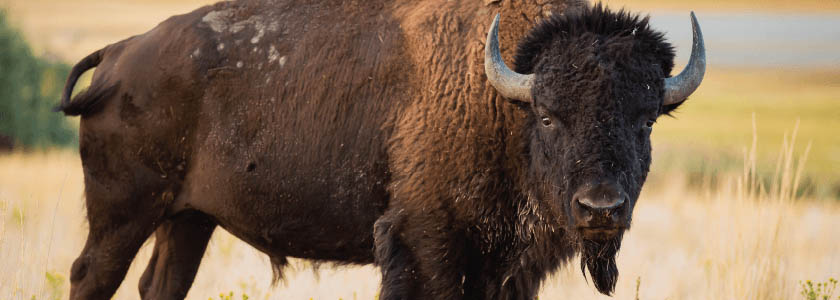Genetically Pure American Bison: How Many Are Left?

Every year, millions of visitors descend upon a remote corner of Wyoming to witness one of the world’s most memorable landscapes.
Yellowstone National Park, the world’s first, is home to soaring snowcapped peaks, bubbling mud pits, gushing geysers, and vast valleys brimming with free-roaming wildlife.
Yellowstone has rightly been called America’s Serengeti. Here you can find an ecosystem rare in the world, one in which predators at the top of the food chain—grizzly bears, wolves, and wolverines—prowl epic panoramas unimpeded.
Yellowstone's Wild Bison Genetic Diversity
Few of Yellowstone’s animals are as iconic as the bison. Weighing up to 2,000 pounds, living for two decades or more, and calling the Yellowstone region home since prehistoric times, the American bison here munch on grass, cross broad landscapes in herds numbering into the hundreds, are bedecked with snow and frosty icicles in winter, and occasionally destroy rental cars. Yellowstone’s bison are unique in other ways less visible to visitors: these animals have never interbred with domestic cattle.
It’s true: Despite their outsized presence and growing numbers, bison are threatened. It’s their genetic diversity that’s at risk.
“Evidence is mounting that wild North American bison are gradually shedding their genetic diversity across many of the isolated herds overseen by the U.S. government,” reported the Associated Press in 2019, “weakening future resilience against disease and climate events in the shadow of human encroachment.”
Advances in genetic studies have revealed that America’s bison—the animal is such a part of the nation’s lore it appears has appeared on the nation’s currency over the course of the last century—have lost so much genetic diversity that smaller herds are in danger of becoming extinct.
Genetic diversity is vital as it helps maintain the health of a population. Genetic variability can help plants and animals resist disease, shrug off pests, and handle other stresses. Whether we are talking bald eagles or corn, diversity provides a population with a buffer against change and the ability to adapt to new environments.
How Many American Bison Are Left?
“Bison squeezed through a perilously small genetic bottleneck in the late 1800s with the hunting and extermination of the massive animals that had numbered in the tens of millions,” the AP wrote. “At one point, fewer than 1,000 survived.”
Actually, the number was probably smaller than that. One study estimates there were 100 American bison descended from plains stock, and about 250 Canadian bison residing in five private herds which included wood bison.
Restoration efforts succeeded, however, and there are now about 11,000 genetically pure bison in the country. But those animals are segregated into small, isolated herds, most with a few hundred animals, leaving them prone to inbreeding and genetic drift.Small herds identified as threatened include those found in a national park in Alaska, at a game preserve in Oklahoma, and in an educational display in North Dakota.
The exchange of just a few bison between herds every decade or so could slow the genetic deterioration of small herds, though that does not stop the genetic diversity problem. For that, said Cynthia Hartway, a conservation scientist at the Wildlife Conservation Society, the species needs more large herds like the one found at Yellowstone. Frozen embryos and in vitro fertilization could be another fix, although these solutions would exempt the existing herds from natural selection.
Native bison are threatened in another way—over the decades, many were bred with domestic cattle to produce a bison species with more meat and a docile behavior. A 2007 study using DNA markers found low amounts of cattle ancestry in conservation herds that were managed as pure bison herds.
Which brings us back to Yellowstone and the somewhat recent realization that the burly bison blocking traffic on the road between Mammoth Hot Springs and Tower Junction are more biologically important than the average tourist realizes: besides those bison there is only one other herd (at a national park in South Dakota) which researchers are reasonably confident is free of cattle ancestry.
“Even with the greatly reduced genetic odds, bison have survived and continue to thrive both in wild herds and in domestic production herds,” notes an article from the National Park Service.
“Some geneticists believe that this is because the last bison survived in multiple geographically diverse areas from amongst the historic range, that the bottleneck retained important ‘adaptability’ genes from across the historic range, and new genetic variation may have been introduced through some early 20th century efforts to hybridize captive bison with domestic cattle (although most would argue this was ultimately detrimental to the wild species).
Future of Wild American Bison
For the future, continued conservation of the bison genetics that survived the 19th century, as well as protecting the opportunities for continuing wild bison evolution, remains a high priority for the ultimate recovery of the wild bison.”
